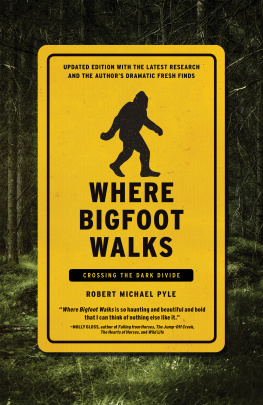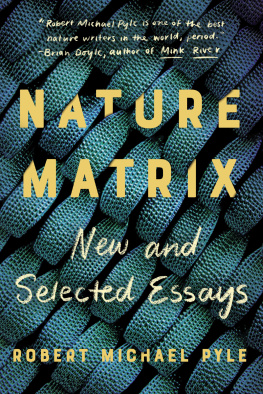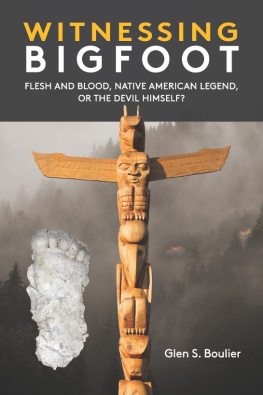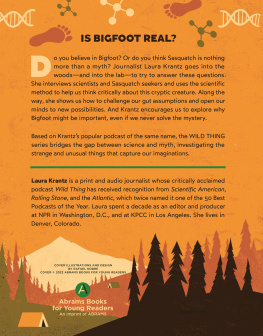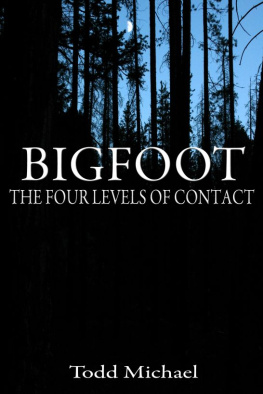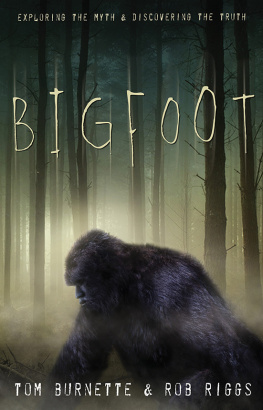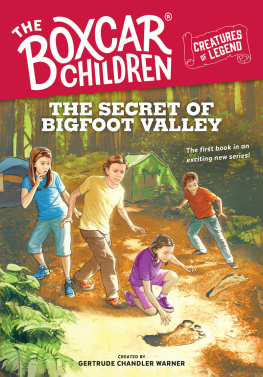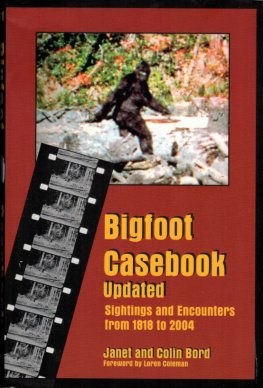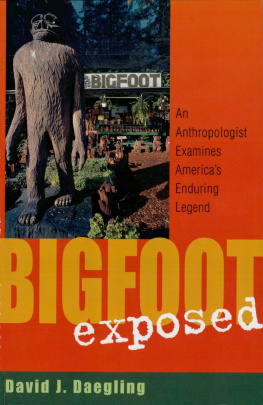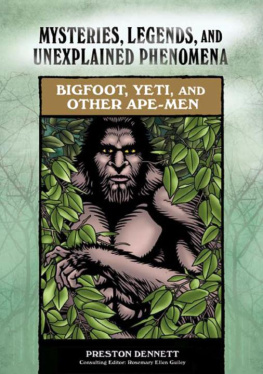

Books by ROBERT MICHAEL PYLE
PROSE
Wintergreen: Rambles in a Ravaged Land
The Thunder Tree: Lessons from an Urban Wildland
Where Bigfoot Walks: Crossing the Dark Divide
Nabokovs Butterflies (editor, with Brian Boyd and Dmitri Nabokov)
Chasing Monarchs: Migrating with the Butterflies of Passage
Walking the High Ridge: Life as Field Trip
Sky Time in Grays River: Living for Keeps in a Forgotten Place
Mariposa Road: The First Butterfly Big Year
The Tangled Bank: Writings from Orion
Through a Green Lens: Fifty Years of Writing for Nature
POETRY
Letting the Flies Out (chapbook)
Evolution of the Genus Iris
Chinook and Chanterelle
ON ENTOMOLOGY
Watching Washington Butterflies
The Audubon Society Field Guide to North American Butterflies
The IUCN Invertebrate Red Data Book
(with S. M. Wells and N. M. Collins)
Handbook for Butterfly Watchers
Butterflies: A Peterson Field Guide Coloring Book
(with Roger Tory Peterson and Sarah Anne Hughes)
Insects: A Peterson Field Guide Coloring Book (with Kristin Kest)
The Butterflies of Cascadia

Where Bigfoot Walks
Copyright 1995 , 2017 by Robert Michael Pyle
First Counterpoint paperback edition: November 2017
All rights reserved under International and Pan-American Copyright Conventions. No part of this book may be used or reproduced in any
manner whatsoever without written permission from the publisher, except in the case of brief quotations embodied in critical articles and reviews.
eISBN: 9781619029651
Library of Congress Cataloging-in-Publication Data is available.
Cover designed by Faceout Studio, Charles Brock
Book designed by Domini Dragoone
COUNTERPOINT
2560 Ninth Street, Suite
Berkeley, CA 94710
www.counterpointpress.com
Printed in the United States of America
Distributed by Publishers Group West
FOR THEA
For all the searchers and dreamers
For the Ones who walk in mystery
Contents
A giant has swallowed the earth,
And when he sleeps now, oh when he sleeps,
How his eyelids murmur, how we envy his dream.
Pattiann Rogers, Firekeeper
Introduction
Bukwus and Dzonoqua at Play
This was DSonoqua, and she was a supernatural being, who belonged to these Indians... I said to myself, I do not believe in supernatural beings. Stillwho understands the mysteries behind the forest? What would one do if one did meet a supernatural being? Half of me wished that I could meet her, and half of me hoped I would not.
Emily Carr, Klee Wyck
S omething is definitely afoot in the forests of the Pacific Northwest. Either an officially undescribed species of hominoid primate dwells there, or an act of self- and group deception of astonishing proportions is taking place. In any case the phenomenon of Bigfoot exists. Whether the animals themselves are becoming scarcer or whether they even walk as corporeal creatures at all, their reputation and cult are only growing. More and more people, including credible and skeptical citizens and scientists, as well as the gullible, the wishful, and the wacko, believe that giant hairy monsters are present in our midst. What does this mean? Who is this beast, described by the great ecologist G. Evelyn Hutchinson as our shadowy, perplexing, and perhaps non-existent cousin?
Bigfoot, also commonly called Sasquatch (from the Salish saskehavas ), is the North American counterpart of Yeti, or the abominable snowman, in the Himalaya. Cryptozoologists, who study undiscovered animals, now recognize at least four possible species (other than humans) of upright apes in Asia, of which Yeti is one. They tend to think that the North American animal represents a single, different species. Although reports, tracks, and putative sightings have come from almost every state in recent years, most of the lore centers on the Pacific Northwest, from northern California to central Alaska, and especially southwestern Washington.
Arriving on the continent, European settlers encountered a rich and varied array of native tales concerning giant, hairy, humanlike monsters. Native Americans, from the Hoopa of the redwood forests to the Athabascans of the Yukon River, have stories of hairy giants. And the Sasquatch stories did not arrive with trade beads; for centuries the Kwakiutl of the British Columbia coast have consorted with the wild men and wild women of the woods.
Mountain men, trapping far beyond the westward advance of their racial kin, brought tales of ape-men along with beaver pelts to the rendezvous at Jackson Hole. Teddy Roosevelt, in The Wilderness Hunter , recorded the story of one such trapper raked off by an unknown beast at his campfire while his partner checked the trapline; Roosevelt called it the Snow Walker. Pioneer trainmen in the Fraser River country stopped to catch and cage a baby ape found near the rails; named Jacko, he was extolled in the press and exhibited for a while, then disappeared. A British Columbian fisherman, Albert Ostman, returned from a wild inlet to tell of being kidnapped by a family of Bigfeet and kept captive until he freed himself by sharing his snuff. The same year, 1924 , the famous Ape Canyon incident took place, when miners in Washingtons Skamania County reported shooting a Bigfoot and then being attacked by several others.
Reports continued to generate from Skamania County, and in 1969 an ordinance was passed protecting Bigfoot. Monster hunters Roger Patterson and Robert Gimlin, encountering a female ape of great proportions on a northern California stream, returned with a shaky film shot on the run when Patterson was bucked from his horse. Shown worldwide, the film set off an epidemic of hunters, who dispatched reports no more or less compelling than the hundreds of tracks and glimpses and fuzzy photos and hanks of hair turned up by ordinary folk with no monsters aforethought. Bigfoot societies were formed and expeditions mounted as hundreds of huge humanoid tracks were discovered, from Maryland to Minnesota, from Pikes Peak to Mount Hood.
Most academics and forest managers remained firmly unconvinced, while the growing cadres of true believers argued over whether or not to kill the animal when it was found. Movie spoofs and tabloid dramas fanned the flickers of the faithful while degrading a once-powerful set of native traditions into a staple of kitsch journalism. Thus have we come from the early frontier fables of bogeymen, which accompany every advance into the wilderness, to a state of mass fascination mixed with general unbelief.
As assembled from some hundreds of eyewitness reports, traditional legends, tracks and other signs, a few vague photographs, and the famous filmstrip made by Patterson and Gimlin at Bluff Creek in 1967 , a portrait of Bigfoot emerges fairly clearly. The animal is large or immense, from six to ten feet in height and weighing perhaps three hundred pounds to half a ton when mature. It stands upright, and though its powerful arms are long, they do not touch the ground, as those of the great apes do. Russet, beige, brown, or black fur covers the massive body except for the palms, soles, and most of the face. The neck is short, the sagittal crest pronounced, the brows heavy and beetling. Bigfoot may have red eyeshine in headlights. Males have small genitals and are half again as large as females, whose breasts can be pendulous, as Pattersons film shows. Almost all observers agree that the animal leaves behind a very strong disagreeable odor and that the face is more humanlike than animal.
Next page
